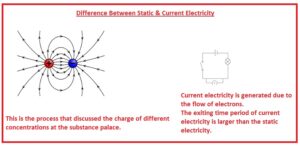 Hello, friends, I hope you all are doing great. In today’s tutorial, we will discuss the Difference Between Static & Current Electricity. In static electricity the charges do not move and these retain at the surface of the material. While in the case of current electricity electrons flow in the conductive body. The static electricity is used in machines used to control pollution, painting machine, and xerography..
Hello, friends, I hope you all are doing great. In today’s tutorial, we will discuss the Difference Between Static & Current Electricity. In static electricity the charges do not move and these retain at the surface of the material. While in the case of current electricity electrons flow in the conductive body. The static electricity is used in machines used to control pollution, painting machine, and xerography..
While current electricity is used to perform different operations such as fan working, motor operation. In today’s post, we will have a detailed look at both static and current electricity with the details and find their differences. So let’s get started with the Difference Between Static & Current Electricity.
Difference Between Static & Current Electricity
Static Electricity
- This is the process that discussed the charge of different concentrations at the substance palace.
- The charge stays in its position till it is connected to the current.
- The static charge produced when 2 pats of any material are created and when parts show the high value of resistance for current
- The practical example if static electricity occurs when natural opposite charges make the connection that spark occurs.
- An example of this process is electrostatic discharge
- It produces the motion of negative charges between two bodies.
- The instrument used to measure the static electricity is a Gold leaf electroscope.
- This electricity can be generated in both conductive and insulator materials.
- In this electricity, there is no induction of a magnetic field.
- The static electricity is generated for a short period.
- Examples of static electricity are lightning strokes, it can also be generated with rubbing balloons on hair,
Current Electricity
- Current electricity is generated due to the flow of electrons.
- The exiting period of current electricity is larger than the static electricity.
- There are two main types of current electricity dc and AC
- In DC the polarity of the current is constant
- In AC polarity of current changes after a certain time interval
- AC is produced through ac generator like a synchronous generator
- DC is produced through dc generator battery and the cell also gives DC
- Its value can be measured with the use of analog and digital meters.
- Its common applications are working fans, tube lights, machines, motors, etc.
- The main cause of current electricity is the motion of electrons.
- The current electricity is generated only in conductive substances.
- Current electricity produces a magnetic field.
Static Electricity vs Current Electricity
Static Electricity
- The electricity that is generated through gathering charges on object surfaces is called static electricity.
- It does not cause the current flow in the body
- It exists for a short duration
- It is produced in both conductor and insulator.
- It does not produce a magnetic field.
- It is defined as the rubbing of two bodies with each other
- The nature of static electricity is defined with the use of a gold leaf electroscope.
- Common examples of static electricity are lightening strokes and crackling sounds made by woolen clothes
Current Electricity
- It is generated with the motion of charges in the body.
- It causes current flow in bodies.
- It has existed for a longer time
- It produces in conductors.
- It generated a magnetic effect.
- It is defined through voltage-providing voltage about the conductor.
- The ammeter, galvanometer, multimeter are used for measuring the current electricity.
- Common examples are glowing lamps, heating of electric iron running fans or pump motors, electric shocks, etc.
What is the difference between static electricity and discharge?
- Static electricity is the creation of electric charges on objects and occurs when electrons are shifted from one body to another. The abrupt flow of electrons from one charged particle to another is called static discharge
Is static electricity AC or DC?
- Static electricity is the creation of electric charges on the body’s surface. It is static since there is no flow of AC or DC.
How many volts is static electricity?
- For severe conditions, there are about 15000 volts and normally it can be about 5000 volts. Some people get shock from static electricity discharge for 2,000 to 4,000V.
What are examples of static?
- Shocks from objects.
- Lightning.
- A charged balloon sticking to a wall.
- Charged comb picking small paper.
Read also
That is detailed post about the difference between static and current electricity if you have any query ask in comments. Thanks for reading. Have a good day.





